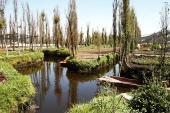My experience:
-florescent lights seem to be good for starts. I use grow bulbs, have heard using a warm white and a cool white bulb works fine
-florescents produce a fair amount of heat and have caused overheating problems when used in an enclosed cabinet
-stacking them can provide the warmth needed rather than having to use warming pads. I have had problems with overheating with an enclosed stack.
-you can have a little more selection of light spectrum using LEDs
-being able to adjust the height of the lamps above the plants is a must to prevent them becoming too leggy
-the LED lights can be hard on the eyes and somewhat blinding. There are special glasses you can use to avoid damage from too much exposure
-LED lights are more focused than florescent so I would tend to go with LED if you are using an open rack in front of a window, florescent with the lining below if enclosed.
-hydroponic shops sell a white one side, silver the other plastic that can be used to "wrap" your grow areas to keep the light and moisture in
-next year I think I will go with a florescent 2 tube fixture and an LED fixture in each 2x4 bay, stacked 3 high, seeds on top where its warmest and migrating the trays downward as they grow
my 2cents worth.









